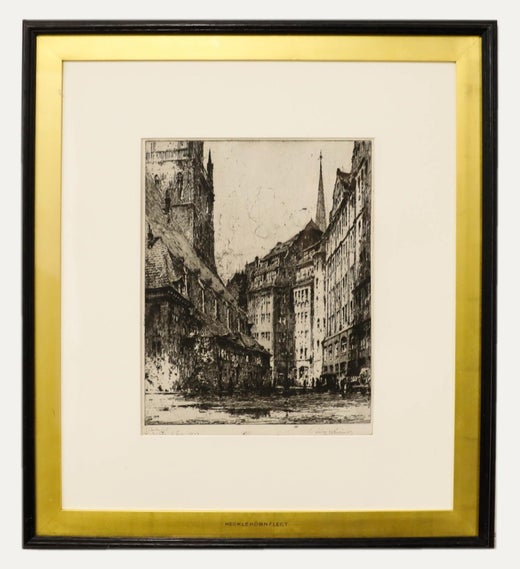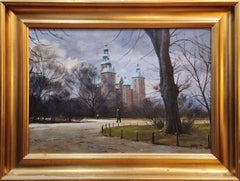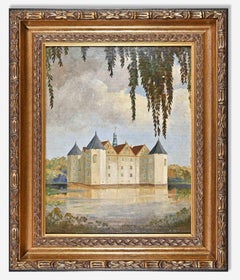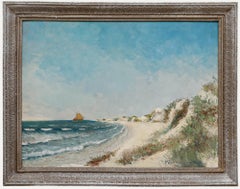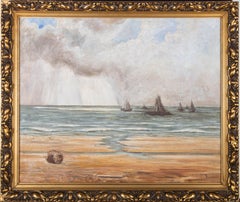Want more images or videos?
Request additional images or videos from the seller
1 of 11
Luigi KasimirKronborg Slot1919
1919
$1,100
£830.14
€950.38
CA$1,551.36
A$1,703.20
CHF 888.57
MX$20,611.15
NOK 11,136.79
SEK 10,493.79
DKK 7,094.37
About the Item
This artwork titled "Kronborg Slot" 1919, is a color etching by Austrian artist Luigi Kasimir 1881-1962. It is hand signed by the estate in pencil at the lower center. The plate mark (image) size is 17 x 22.75 inches, framed size is 28.75 x 34.85 inches. Custom framed in a distressed style wood and black frame, with fabric matting and dark grey fillet . It is in excellent condition.
About the artist.
Luigi Kasimir was born in 1881 at Pettau, today Ptuj, Slovenia, then a part of the Austro-Hungarian monarchy. He inherited his talent from his ancestors; his grandfather was a painter and a poet, and his father an officer in the Habsburg army, who later became a professional painter. Kasimir attended the Vienna Academy of Art where he studied under Wilhelm Unger, who introduced him to the technique of the coloured etching, and also to his future wife, the artist Tanna Hoernes.[1] He died in 1962 in Grinzing, a suburb of Vienna.Kasimir was among the first to develop the technique of the coloured etching. Before this, prints were usually hand-coloured with the colour being applied in a casual, haphazard manner. Kasimir would first create a sketch usually in pastel, he then transferred the design on as many as four to six plates, printing one after the other and applying the colour on the plate, all done by hand.
Kasimir is mainly famous for his etchings, but he also produced some oil painting, as well as some pastels. One of his favourite genres was the landscape, or veduta. He demonstrated a predisposition street scenes, and tourist landmarks. He depicted places from all over Europe, mainly Italy, Austria, and Germany. He also travelled to the United States to do a series of etchings of famous sights ranging from urban landmarks such as New York City skyscrapers, to natural wonders like Yosemite Valley. Luigi Kasimir’s etchings can be seen in many galleries and museums, from the New York Metropolitan Museum of Art to countless galleries and fine print collections around the world.
- Creator:Luigi Kasimir (1881 - 1962, Austro-Hungarian)
- Creation Year:1919
- Dimensions:Height: 28.75 in (73.03 cm)Width: 34.85 in (88.52 cm)Depth: 1.35 in (3.43 cm)
- Medium:
- Movement & Style:
- Period:
- Condition:
- Gallery Location:San Francisco, CA
- Reference Number:Seller: Kas/kro/slo/011stDibs: LU666312230402
Luigi Kasimir
Alois Heinrich “Luigi” Kasimir (Austrian, 1881-1962) was born on April 18, 1881 in Ptuj, Austria (today Slovenia) then a part of the Austro-Hungarian monarchy. He may have inherited his talent from his ancestors; his grandfather was a painter and a poet, and his father, an officer in the Habsburg army, who later became a professional painter. Kasimir attended the Vienna Academy of Art where he studied under Willhelm Unger, who introduced him to the technique of the color etching, and also to his future wife, the artist Tanna Hoernes. Kasimir was among the early practitioners of the multi-plate color etching. Before this, prints were usually hand-colored with the color being applied in a casual, haphazard manner. Kasimir would first create a sketch—usually in pastel. He then transferred the design on as many as four to six plates, printing one after the other and applying the color to the plate - all done by hand. Although Luigi Kasimir is mainly famous for his etchings, but he also produced some oil painting, as well as some pastels. One of his favorite genres was the landscape. He demonstrated a predisposition for monuments, street scenes, and tourist landmarks. He depicted places from all over Europe, mainly Italy, Austria, and Germany. He also travelled to the United States to do a series of etchings of famous sights ranging from urban landmarks such as New York skyscrapers to natural wonders like California’s Yosemite Valley. Kasimir designed a bookplate for Sigmund Freud, who also hung an etching of the Roman Forum by Kasimir in his consulting room. Kasimir’s wife, Tanna and their son Robert worked in a similar style. Luigi Kasimir died in 1962 in Grinzing, a suburb of Vienna, Austria
About the Seller
5.0
Platinum Seller
Premium sellers with a 4.7+ rating and 24-hour response times
Established in 1999
1stDibs seller since 2017
839 sales on 1stDibs
Typical response time: 1 hour
- ShippingRetrieving quote...Shipping from: San Francisco, CA
- Return Policy
Authenticity Guarantee
In the unlikely event there’s an issue with an item’s authenticity, contact us within 1 year for a full refund. DetailsMoney-Back Guarantee
If your item is not as described, is damaged in transit, or does not arrive, contact us within 7 days for a full refund. Details24-Hour Cancellation
You have a 24-hour grace period in which to reconsider your purchase, with no questions asked.Vetted Professional Sellers
Our world-class sellers must adhere to strict standards for service and quality, maintaining the integrity of our listings.Price-Match Guarantee
If you find that a seller listed the same item for a lower price elsewhere, we’ll match it.Trusted Global Delivery
Our best-in-class carrier network provides specialized shipping options worldwide, including custom delivery.More From This Seller
View AllMarienburg Castle, Germany
By Luigi Kasimir
Located in San Francisco, CA
This artwork "Marienburg Castle, Germany" 1920, is a color etching by Austrian artist Luigi Kasimir 1881-1962. It is hand signed by the estate in pencil at the lower center. The plate mark (image) size is 17.25 x 23 inches, framed size is 28.75 x 33 inches. Custom framed in a wooden gold and silver distressed frame, with fabric matting and dark grey color small fillets. It is in very good condition, the paper is slightly toned by age, it have a small discoloration near the signature, see picture #7
About the artist.
Luigi Kasimir was born in 1881 at Pettau, today Ptuj, Slovenia, then a part of the Austro-Hungarian monarchy. He inherited his talent from his ancestors; his grandfather was a painter and a poet, and his father an officer in the Habsburg army, who later became a professional painter. Kasimir attended the Vienna Academy of Art where he studied under Wilhelm Unger, who introduced him to the technique of the coloured etching, and also to his future wife, the artist Tanna Hoernes.[1] He died in 1962 in Grinzing, a suburb of Vienna.Kasimir was among the first to develop the technique of the coloured etching. Before this, prints were usually hand-coloured with the colour being applied in a casual, haphazard manner. Kasimir would first create a sketch usually in pastel, he then transferred the design on as many as four to six plates, printing one after the other and applying the colour on the plate, all done by hand.
Kasimir is mainly famous for his etchings, but he also produced some oil painting, as well as some pastels. One of his favourite genres was the landscape, or veduta. He demonstrated a predisposition street scenes, and tourist landmarks. He depicted places from all over Europe, mainly Italy, Austria, and Germany. He also travelled to the United States to do a series of etchings of famous sights ranging from urban landmarks such as New York City skyscrapers, to natural wonders like Yosemite Valley. Luigi Kasimir’s etchings...
Category
Early 20th Century Realist Figurative Prints
Materials
Etching
Innenhof auf Schloss Schallaburg
By Luigi Kasimir
Located in San Francisco, CA
This artwork titled "Innenhof auf Schloss Schallaburg" c.1930 is a color etching on wove paper by Austrian artist Luigi Kasimir, 1881-1962. It is hand signed by the artist's estat...
Category
Early 20th Century Realist Figurative Prints
Materials
Etching
Wien
By Luigi Kasimir
Located in San Francisco, CA
This artwork titled "Wien" 1911, is a color etching on paper by Austrian artist Luigi Kasimir, 1881-1962. It is hand signed in pencil by the artist's estate at the lower center. The ...
Category
Early 20th Century Realist Figurative Prints
Materials
Etching
Persenbeug Castle, Austria
By Luigi Kasimir
Located in San Francisco, CA
This artwork titled "Persenbeug Castle, Austria" c.1930 is a color etching and aquatint on watermarked Kasimir Vienna Wove paper by Austrian artist Luigi Kasimir, 1881-1962. It is ha...
Category
Early 20th Century Realist Figurative Prints
Materials
Etching
Turmgasschen
By Luigi Kasimir
Located in San Francisco, CA
This artwork titled "Turmgasschen" 1935 is an original color etching by Austrian artist Luigi Kasimir 1881-1962. It is hand signed in pencil at the lower center by the artist and titled in the plate. The plate mark (image) size is 15.5 x 10 inches, framed is 24.35 x 17.5 inches. It is custom framed in a dark wood frame, with light creme color matting and light brown filet. It is in very good condition, the frame have some scratches.
Luigi Kasimir was born in 1881 at Pettau, today Ptuj, Slovenia, then a part of the Austro-Hungarian monarchy. He inherited his talent from his ancestors; his grandfather was a painter and a poet, and his father an officer in the Habsburg army, who later became a professional painter. Kasimir attended the Vienna Academy of Art where he studied under Wilhelm Unger, who introduced him to the technique of the coloured etching, and also to his future wife, the artist Tanna Hoernes.[1] He died in 1962 in Grinzing, a suburb of Vienna.Kasimir was among the first to develop the technique of the coloured etching. Before this, prints were usually hand-coloured with the colour being applied in a casual, haphazard manner. Kasimir would first create a sketch usually in pastel, he then transferred the design on as many as four to six plates, printing one after the other and applying the colour on the plate, all done by hand.
Kasimir is mainly famous for his etchings, but he also produced some oil painting, as well as some pastels. One of his favourite genres was the landscape, or veduta. He demonstrated a predisposition street scenes, and tourist landmarks. He depicted places from all over Europe, mainly Italy, Austria, and Germany. He also travelled to the United States to do a series of etchings of famous sights ranging from urban landmarks such as New York City skyscrapers, to natural wonders like Yosemite Valley. Luigi Kasimir’s etchings...
Category
Early 20th Century Realist Figurative Prints
Materials
Etching
Jagellonian Library, Krakau, Poland
By Luigi Kasimir
Located in San Francisco, CA
This artwork titled " Jagellonian Library, Krakau, Poland" 1941 is an original color etching by Austrian artist Luigi Kasimir 1881-1962. It is hand signed in pencil at the lower righ...
Category
Early 20th Century Realist Figurative Prints
Materials
Etching
You May Also Like
Early 20th Century Painting of Fredericksborg Castle, Denmark, Signed Nissen
Located in Grand Rapids, MI
Signed: Nissen (Lower, Right)
" Frederiksborg Castle ", circa 1930s
Oil on Canvas
18" x 26"
Housed in a 3 1/4" Frame
Overall Size: 23 1/2" x 31 1/4"
Minor ware to frame and ca...
Category
Early 20th Century Landscape Paintings
Materials
Canvas, Oil
Glücksburg Castle near Flensburg - Oil Painting- Early 20th Century
Located in Roma, IT
Glücksburg Castle near Flensburg is an original modern artwork realized in the first half of 20th Century
Oil on hardboard.
Hand signed "H. Th. Nöbbe" on the lower margin.
Include...
Category
Early 20th Century Modern Figurative Paintings
Materials
Oil
Heinz Mindermann - 20th Century Oil, The Coast of Norderney
Located in Corsham, GB
This coastal landscape painting depicts a serene seashore scene with rolling waves washing onto a sandy beach, while a small sailing vessel with distinctive reddish-brown sails navig...
Category
20th Century Figurative Paintings
Materials
Oil
I. De Caster - Mid 20th Century Oil, Grey Coastline
Located in Corsham, GB
A fine coastal scene in oil showing a beach with sailboats out to sea and the sun glancing down through the grey clouds overhead. The artist has signed to the lower right corner an t...
Category
Mid-20th Century Figurative Prints
Materials
Oil
$379 Sale Price
20% Off
Halmstad Harbour Seen From the North, 1889
Located in Stockholm, SE
The painting "Halmstad Harbour Seen From the North" by Oscar Ohlson is a captivating snapshot of daily life and historical architecture, frozen in time from the year 1889. With a meticulous eye for detail, Ohlson has rendered approximately 25 boats in the harbor, each brimming with the quiet bustle of daily chores. The painting invites viewers to step into a moment where people converse, work, and seek respite from the sun under shared umbrellas, while wisps of smoke subtly rise from several boats, suggesting the presence of life and activity beyond the canvas.
In this vibrant scene, a man carries a sack, perhaps fresh merchandise from one of the docked vessels, while others engage in conversation, highlighting the social tapestry of the harbor. Ohlson's masterful use of light reflects on the water, creating a shimmering path that leads the eye to the majestic Halmstad Castle, which adorns the right side of the painting. This historic building, beautifully situated by the Nissan river and not far from the sea, is a testament to Halmstad's past as a Danish territory. Constructed in the early 17th century during the reign of King Christian IV, the castle stands as a reminder of the town's rich history and cultural heritage.
The first building to the right, once part of this historic tableau, has been removed to accommodate modern necessities, replaced by a road that now runs through its former site. This juxtaposition of past and present is a poignant commentary on the evolution of cities and the sacrifices made in the name of progress.
Halmstad itself, a town that straddles the Nissan river, retains much of its early 20th-century character in its city core. Low brick and half-timbered houses, some dating back to the 17th century, dot the landscape. The town center on the west side of Nissan is bordered by remnants of early 17th-century fortifications, including the 1600s castle, Norre Port from 1601, and King Charles XI's path along the old fortress wall. At the heart of the town is Stora Torg with Carl Milles' Europa and the Bull fountain from 1926, and the town hall built in 1938. The city layout, influenced by Renaissance planning, converges at Stora Torg, which is also home to the town's sole medieval building, the brick hall church of St. Nikolai from the 14th century.
Oscar Ohlson (1847-1912), a native of Linneryd, Småland, was a multifaceted individual. Beginning his career with a legal degree from Uppsala University in 1870, Ohlson's passion for the arts led him to pursue music studies before dedicating himself to art under the guidance of Alfred Wahlberg...
Category
1880s Realist Landscape Paintings
Materials
Canvas, Oil
French Seascape, Oil on Board
By Jules Leblay
Located in Surfside, FL
Oil on board, french artist, SIGNED.
Seascape painting with a lone figure standing by the shore set against an architectural background. A path is drawn in the sand from the figure. ...
Category
20th Century Realist Landscape Paintings
Materials
Oil, Board
More Ways To Browse
Antique Slot
Astro Boy
Basquiat Signed
Bill Schenck
Bob Dylan Poster Milton Glaser
Chagall Tamar
Circus Etching
Dali Hand Signed Etching
Derrick Adams
Ed Mell
Fairy Tale Illustration
Finger Pointing
Four Poster Bed With Birds
Francoise Gilot Drawing
Frederick J Brown
Genji Print
Goya Disparate
Grant Wood American Gothic
